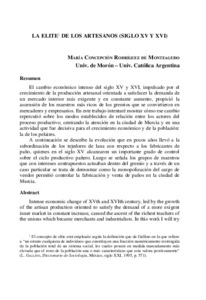Por favor, use este identificador para citar o enlazar este ítem:
https://repositorio.uca.edu.ar/handle/123456789/16728| Título: | La elite de los artesanos (siglo XV y XVI) | Autor: | Rodríguez De Monteagudo, María Concepción | Palabras clave: | HISTORIA DE ESPAÑA; EDAD MEDIA; ARTESANOS; PELAIRE; HISTORIA SOCIAL; HISTORIA ECONOMICA; ELITE; GREMIOS | Fecha de publicación: | 2005 | Editorial: | Pontificia Universidad Católica Argentina. Facultad de Filosofía y Letras. Instituto de Historia de España | Cita: | Rodríguez De Monteagudo, M. C. La elite de los artesanos (siglo XV y XVI) [en línea]. Estudios de Historia de España. 2005 (7). Disponible en: https://repositorio.uca.edu.ar/handle/123456789/16728 | Resumen: | Resumen:
El cambio económico intenso del siglo XV y XVI, impulsado por el
crecimiento de la producción artesanal orientada a satisfacer la demanda de
un mercado interior más exigente y en constante aumento, propició la
ascensión de los maestros más ricos de los gremios que se convirtieron en
mercaderes y empresarios. En este trabajo intentaré mostrar cómo ese cambio
repercutió sobre los modos establecidos de relación entre los actores del
proceso productivo, centrando la atención en la ciudad de Murcia y en una
actividad que fue decisiva para el crecimiento económico y de la población:
la de los pelaires.
A continuación se describe la evolución que en pocos años llevó a la
subordinación de los tejedores de lana con respecto a los fabricantes de
paño, quienes en el siglo XV alcanzaron un importante grado de control
sobre el ciclo productivo pañero. Luego se señala los grupos de maestros
que con intereses contrapuestos actuaban dentro del gremio y a través de un
caso particular se trata de demostrar como la monopolización del cargo de
veedor permitió controlar la fabricación y venta de paños en la ciudad de
Murcia. Abstract: Intense economic change of XVth and XVIth century, led by the growth of the artisan production oriented to satisfy the demand of a more exigent inner market in constant increase, caused the ascent of the richest teachers of the unions which became merchants and industrialists. In this work I will try to show how that change had an impact on the established ways of relation between the actors of the productive process, focusing attention on the city of Murcia in an activity that was decisive for the economic and for the population growth: the one of pelaires. Inmediately after we describe the evolution that in few years led to the subordination of the wool weavers in respect to the wool manufacturers, who in XVth century reached an important degree of control on the productive cycle of the woolar industry. Afterwards we show the groups of teachers who with opposed interests acted within the union and through a particular case it will be demonstrated how the monopoly of the veedor role allowed the supervision of the manufacture and wool trade in the city of Murcia. |
Cobertura Temporal: | Siglo XV Siglo XVI |
URI: | https://repositorio.uca.edu.ar/handle/123456789/16728 | ISSN: | 0328-0284 2469-0961 (online) |
Disciplina: | HISTORIA | Derechos: | Acceso abierto Atribución-NoComercial-CompartirIgual 4.0 Internacional |
Fuente: | Estudios de Historia de España Vol.7, 2005 |
| Aparece en las colecciones: | EHE - 2005 vol. 07 |
Ficheros en este ítem:
| Fichero | Descripción | Tamaño | Formato | |
|---|---|---|---|---|
| elite-artesanos.pdf | 37,83 kB | Adobe PDF |  Visualizar/Abrir |
Visualizaciones de página(s)
80
comprobado en 27-abr-2024
Descarga(s)
31
comprobado en 27-abr-2024
Google ScholarTM
Ver en Google Scholar
Este ítem está sujeto a una Licencia Creative Commons

